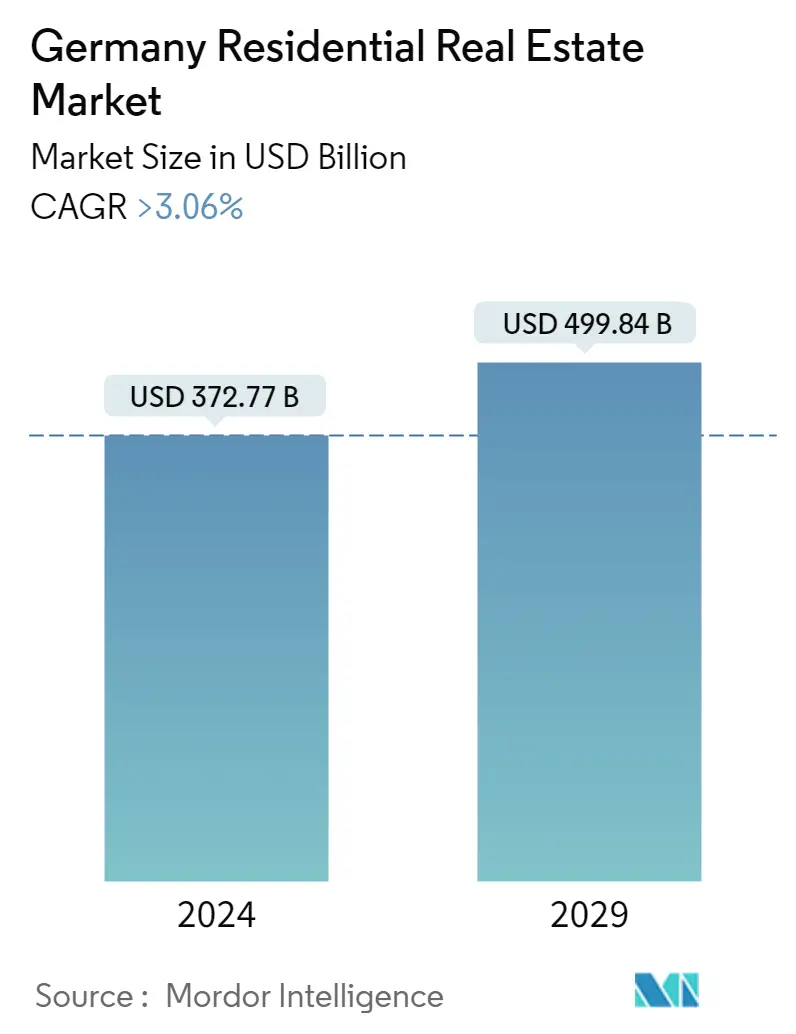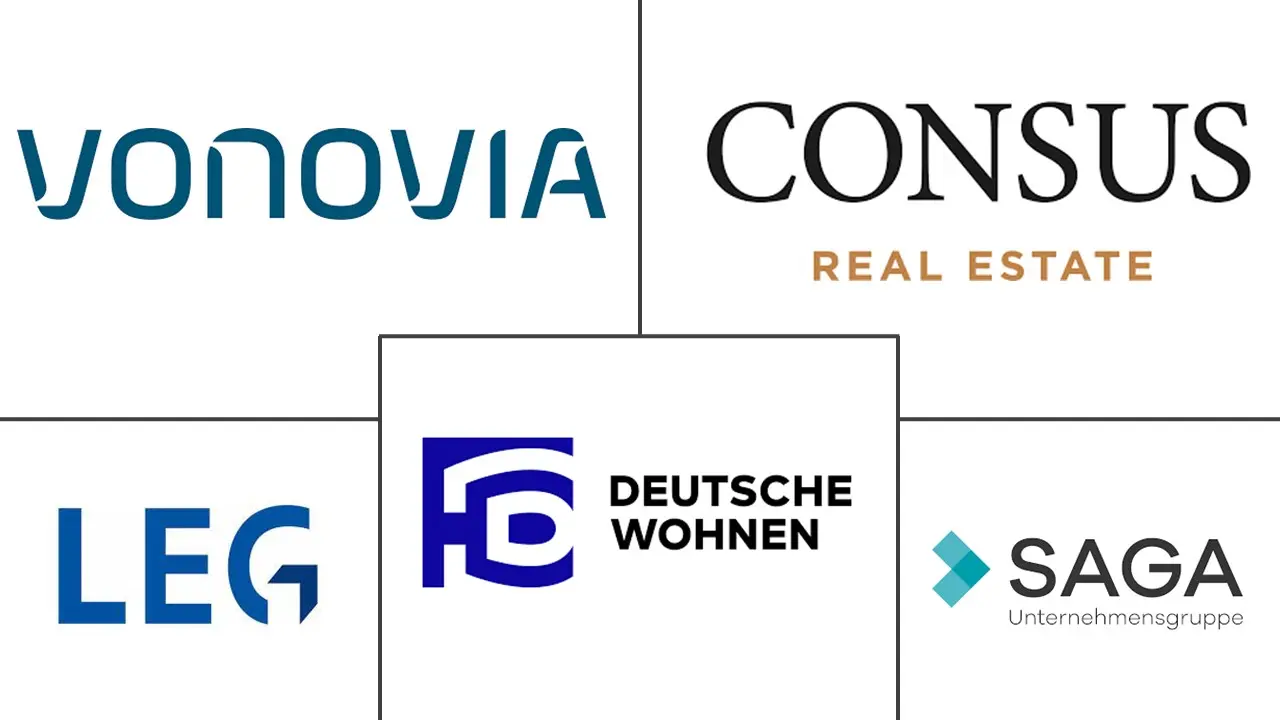Market Size of Germany Residential Real Estate Industry

| Study Period | 2020 - 2029 |
| Base Year For Estimation | 2023 |
| Market Size (2024) | USD 372.77 Billion |
| Market Size (2029) | USD 499.84 Billion |
| CAGR (2024 - 2029) | > 3.06 % |
| Market Concentration | Medium |
Major Players
*Disclaimer: Major Players sorted in no particular order |
Germany Residential Real Estate Market Analysis
The Germany Residential Real Estate Market size is estimated at USD 372.77 billion in 2024, and is expected to reach USD 499.84 billion by 2029, growing at a CAGR of greater than 3.06% during the forecast period (2024-2029).
The sale of residential property in Germany amounted to around EUR 3.7 billion (USD 4 billion) in the first half of 2023. This represented a decrease of 53% compared to the same period of the previous year and, at the same time, the lowest turnover in the first half of the year since 2011. In the year so far, there have been four transactions with volumes of more than a quarter of a billion euros each. These transactions accounted for 62% of the volume. However, according to the experts, about three-quarters of the sales were below EUR 50 million (USD 54 million).
However, several new building sales have been made public over the last few weeks and months, with multipliers exceeding 25 to 27 times annual rentals. Due to such benchmark transactions, the players have more certainty about the potential first yields in buying or selling.
The vacancy rate is already low in many cities and may worsen. Experts indicate that the number of completed units will be around 200,000 in a few years. The federal government has set a new construction target of only half that amount.
The timing may be suitable for owners willing to sell, while a favorable window of opportunity opens for long-term investors wanting to enter the market. The presence of equity investors in the market who stabilize prices, particularly for smaller and medium-sized properties, may favor early sales instead of waiting and observing. However, prices could fall again when this capital is used.
Germany Residential Real Estate Industry Segmentation
Residential real estate refers to land and any buildings for residential purposes. The most common type of residential real estate is single-family dwellings. A complete background analysis of the German residential real estate market, including the assessment of the economy and contribution of sectors in the economy, market overview, market size estimation for key segments, and emerging trends in the market segments, market dynamics, and geographical trends, and COVID-19 impact, is covered in the report.
The German residential real estate market is segmented by type (villas, landed houses, condominiums, and apartments) and key cities (Berlin, Hamburg, Cologne, Munich, and the Rest of Germany). The report offers market size and forecasts for all the above segments in value (USD).
| By Type | |
| Villas and Landed Houses | |
| Condominiums and Apartments |
| By Key Cities | |
| Berlin | |
| Hamburg | |
| Cologne | |
| Munich | |
| Rest of Germany |
Germany Residential Real Estate Market Size Summary
The residential real estate market in Germany is poised for growth over the forecast period, driven by a combination of economic stability, urbanization, and high demand for housing, particularly in major cities like Berlin, Munich, and Hamburg. Despite a recent decline in property sales and a decrease in building permits, the market remains attractive to long-term investors due to low vacancy rates and the potential for future price appreciation. The presence of equity investors helps stabilize prices, especially for smaller and medium-sized properties, although challenges such as high construction costs and material shortages continue to impact the supply side. The government's construction targets and infrastructure investments are crucial in addressing the supply-demand imbalance, which has been a significant obstacle to market growth.
The German residential real estate market is characterized by a steady rise in property prices, influenced by weak interest rates and a strong labor market. While the growth rate varies by region and property type, urban areas are experiencing the most significant increases, raising affordability concerns. The market is becoming increasingly competitive, with leading players like Vonovia SE, Deutsche Wohnen SE, and others actively engaging in transactions and investments to expand their portfolios. Recent developments, including new construction projects and strategic investments, indicate a positive outlook for the market, although the fragmentation and competitive nature of the sector may present challenges for new entrants. Overall, the market's growth trajectory is supported by ongoing demand, infrastructure spending, and government initiatives aimed at stimulating investment.
Germany Residential Real Estate Market Size - Table of Contents
-
1. MARKET INSIGHTS AND DYNAMICS
-
1.1 Market Overview
-
1.2 Market Drivers
-
1.2.1 Strong Demand and Rising Construction Activities to Drive the Market
-
1.2.2 Rising House Prices in Germany Affecting Demand in the Market
-
-
1.3 Market Restraints
-
1.3.1 Weak economic environment
-
-
1.4 Market Opportunities
-
1.4.1 Recovery in Demand and Supply Demand Due to Government Initiatives
-
-
1.5 Industry Attractiveness - Porter's Five Forces Analysis
-
1.5.1 Bargaining Power of Suppliers
-
1.5.2 Bargaining Power of Buyers/Consumers
-
1.5.3 Threat of New Entrants
-
1.5.4 Threat of Substitute Products
-
1.5.5 Intensity of Competitive Rivalry
-
-
1.6 Government Initiatives and Regulations for the Residential Real Estate Sector
-
1.7 Residential Real Estate Buying Trends - Socio-economic and Demographic Insights
-
1.8 Insights into Size of Real Estate Lending and Loan to Value Trends
-
1.9 Insights into Interest Rate Regime for General Economy and Real Estate Lending
-
1.10 Insights into Rental Yields in the Residential Real Estate Segment
-
1.11 Insights into Capital Market Penetration and REIT Presence in Residential Real Estate
-
1.12 Insights into Affordable Housing Support Provided by Government and Public-private Partnerships
-
1.13 Insights into Real Estate Tech and Startups Active in the Real Estate Segment (Broking, Social Media, Facility Management, and Property Management)
-
1.14 Impact of COVID-19 on the Market
-
-
2. MARKET SEGMENTATION
-
2.1 By Type
-
2.1.1 Villas and Landed Houses
-
2.1.2 Condominiums and Apartments
-
-
2.2 By Key Cities
-
2.2.1 Berlin
-
2.2.2 Hamburg
-
2.2.3 Cologne
-
2.2.4 Munich
-
2.2.5 Rest of Germany
-
-
Germany Residential Real Estate Market Size FAQs
How big is the Germany Residential Real Estate Market?
The Germany Residential Real Estate Market size is expected to reach USD 372.77 billion in 2024 and grow at a CAGR of greater than 3.06% to reach USD 499.84 billion by 2029.
What is the current Germany Residential Real Estate Market size?
In 2024, the Germany Residential Real Estate Market size is expected to reach USD 372.77 billion.

